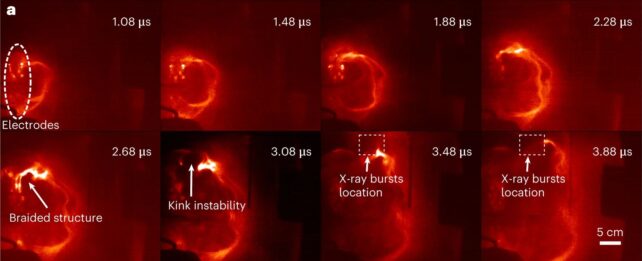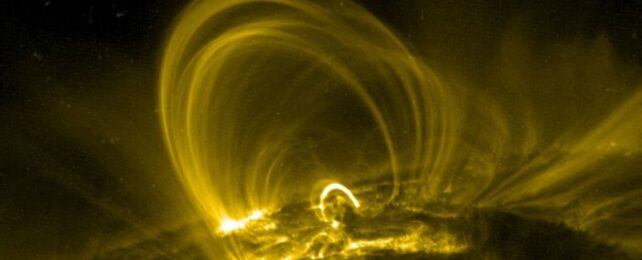Our Sun regularly erupts in tongues of heat and fury so large, our own planet would be dwarfed by their size many times over. To better understand how they work, researchers created a version that could fit inside your lunchbox.
Using an apparatus that turns powerful bursts of electricity into rope-like loops of plasma, a team of physicists modelled solar flares to study the powerful X-rays and energetic particles that stream through the Solar System.
"Solar observations detect energetic particles and hard X-rays but cannot reveal the generating mechanism because the particle acceleration happens at a scale smaller than the observation resolution. Thus, details of the cross-scale physics that explain the generation of energetic particles and hard X-rays remain a mystery," write a team led by physicist Yang Zhang of Caltech.
"Here, we present observations from a laboratory experiment that simulates solar coronal loop physics."
The Sun is a highly dynamic, roiling ball of plasma powered by nuclear fusion, so it's not surprising that it gets up to some shenanigans. Powerful eruptions that eject light and particles out into the space around it can affect the Solar System across significant distances.
We definitely experience those effects here on Earth. The magnetosphere and atmosphere protect us from high-energy hard X-rays, but solar ejecta can interfere with satellites and spacecraft, including navigation and communication technology, and can cause power grid fluctuations and disruptions. So scientists, naturally, want to know more about how the Sun creates and ejects material in the first place.
But there's only so much we can glean from looking at the Sun itself; there's a limit to the scale of the observations we can make using current technology. In order to study those smaller details, physicists have turned to the next best thing: replicating solar flares in a lab.
Physicist Paul Bellan of Caltech designed an experimental apparatus specifically for generating structures known as coronal loops. These are long, closed arcs of ropy glowing plasma erupting from the solar photosphere, along magnetic field lines that protrude into the solar corona. These are often associated with heightened solar activity, such as flares and coronal mass ejections.

This apparatus consists of gas nozzles, electromagnets, and electrodes in a vacuum chamber.
First, the electromagnets are switched on, generating a magnetic field within the vacuum chamber. Then, gas is injected into the electrode region.
A powerful electrical discharge on millisecond scales is then applied via the electrodes; this ionizes the gas, turning it into plasma that then forms a loop constrained by the magnetic field.
"Each experiment consumes about as much energy as it takes to run a 100-watt light bulb for about a minute, and it takes just a couple minutes to charge the capacitor up," Bellan explains.
Each loop lasts just 10 microseconds, and is very small, around 20 centimeters (7.9 inches) in length and a centimeter in diameter. But high-speed cameras record every moment of the loop's generation and propagation, allowing the research team to analyze its formation, structure and evolution in detail.
Scientists have recently learned that coronal loops don't just look like rope, they're structured like it, too. The new work has allowed the team to figure out what role this structure plays in producing solar ejecta.
"If you dissect a piece of rope, you see that it's made up of braids of individual strands," Zhang says. "Pull those individual strands apart, and you'll see that they're braids of even smaller strands, and so on. Plasma loops appear to work the same way."
And it turns out that these strands are responsible for X-ray bursts. Because plasma is a strong conductor, current runs through the loops; but every now and then, the current exceeds the capacity of a loop, like too much water running through a hose.
When this happens, the team's images show, a corkscrew-like instability develops in the loop, and individual strands start to snap, which puts even more pressure on the remaining strands.

When a strand breaks, this produces a burst of X-rays, accompanied by a negative voltage spike, similar to the way pressure drops in a water hose with a kink in it. This voltage drop accelerates charged particles in the plasma; when these particles decelerate, a burst of X-rays is emitted.
Combing through images of coronal loops on the Sun, the researchers identified an instability similar to those observed in the lab that was also associated with an X-ray burst, suggesting that – even though one was banana-sized and the other could comfortably engulf our entire planet – the two phenomena were produced the same way.
Future studies of the Sun will help unravel this process further, but it seems consistent with other studies that have found how snapping and reconnecting magnetic field lines result in powerful bursts of energy. The team intends to follow up by studying the different ways coronal loops can merge and reconfigure to see what kinds of outbursts this activity produces.
The research has been published in Nature Astronomy.
